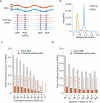Genome sequence-independent identification of RNA editing sites
- PMID: 25730491
- PMCID: PMC4382388
- DOI: 10.1038/nmeth.3314
Genome sequence-independent identification of RNA editing sites
Abstract
RNA editing generates post-transcriptional sequence changes that can be deduced from RNA-seq data, but detection typically requires matched genomic sequence or multiple related expression data sets. We developed the GIREMI tool (genome-independent identification of RNA editing by mutual information; https://www.ibp.ucla.edu/research/xiao/GIREMI.html) to predict adenosine-to-inosine editing accurately and sensitively from a single RNA-seq data set of modest sequencing depth. Using GIREMI on existing data, we observed tissue-specific and evolutionary patterns in editing sites in the human population.
Figures


Similar articles
-
Analysis of RNA Editing Sites from RNA-Seq Data Using GIREMI.Methods Mol Biol. 2018;1751:101-108. doi: 10.1007/978-1-4939-7710-9_7. Methods Mol Biol. 2018. PMID: 29508292
-
L-GIREMI uncovers RNA editing sites in long-read RNA-seq.Genome Biol. 2023 Jul 20;24(1):171. doi: 10.1186/s13059-023-03012-w. Genome Biol. 2023. PMID: 37474948 Free PMC article.
-
Biochemical and Transcriptome-Wide Identification of A-to-I RNA Editing Sites by ICE-Seq.Methods Enzymol. 2015;560:331-53. doi: 10.1016/bs.mie.2015.03.014. Epub 2015 Jul 9. Methods Enzymol. 2015. PMID: 26253977
-
Sequence based identification of RNA editing sites.RNA Biol. 2010 Mar-Apr;7(2):248-52. doi: 10.4161/rna.7.2.11565. Epub 2010 Mar 17. RNA Biol. 2010. PMID: 20215866 Review.
-
The evolution and adaptation of A-to-I RNA editing.PLoS Genet. 2017 Nov 28;13(11):e1007064. doi: 10.1371/journal.pgen.1007064. eCollection 2017 Nov. PLoS Genet. 2017. PMID: 29182635 Free PMC article. Review.
Cited by
-
RNA editing regulates lncRNA splicing in human early embryo development.PLoS Comput Biol. 2021 Dec 1;17(12):e1009630. doi: 10.1371/journal.pcbi.1009630. eCollection 2021 Dec. PLoS Comput Biol. 2021. PMID: 34851956 Free PMC article.
-
Repurposing RNA sequencing for discovery of RNA modifications in clinical cohorts.Sci Adv. 2021 Aug 4;7(32):eabd2605. doi: 10.1126/sciadv.abd2605. Print 2021 Aug. Sci Adv. 2021. PMID: 34348892 Free PMC article.
-
Retrospect of the Two-Year Debate: What Fuels the Evolution of SARS-CoV-2: RNA Editing or Replication Error?Curr Microbiol. 2023 Mar 28;80(5):151. doi: 10.1007/s00284-023-03279-z. Curr Microbiol. 2023. PMID: 36976379 Free PMC article.
-
RED: A Java-MySQL Software for Identifying and Visualizing RNA Editing Sites Using Rule-Based and Statistical Filters.PLoS One. 2016 Mar 1;11(3):e0150465. doi: 10.1371/journal.pone.0150465. eCollection 2016. PLoS One. 2016. PMID: 26930599 Free PMC article.
-
SPRINT: an SNP-free toolkit for identifying RNA editing sites.Bioinformatics. 2017 Nov 15;33(22):3538-3548. doi: 10.1093/bioinformatics/btx473. Bioinformatics. 2017. PMID: 29036410 Free PMC article.
References
Publication types
MeSH terms
Grants and funding
LinkOut - more resources
Full Text Sources
Other Literature Sources

